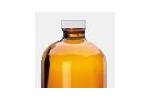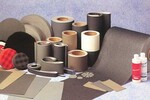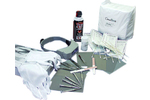- ▶
- Heaters/Source
- ▶
- Agilent Heaters and SensorsMass Spectrometry, Scientific Supplies & ManufacturingScientific Instrument Services 5973 Source Heater Tamper Resistant Allen Wrench 5973/5975 Quad Sensor 5985 Source Heater Assembly Agilent Interface Heater Assembly 5971 Interface Heater

- ▶
- MS Instrument Cleaning Supplies
- Lab/CleanMicro-Mesh® (Fine Cushioned Abrasive) Aluminum Oxide Cleaning Abrasive Fiberglass Cleaning Brushes Swabs and Applicators Nylon and Latex Gloves Cleaning Wipes SIS MS Source Cleaning Kits Dust-Off® Hurricane Canless Air System Wheaton Bottles Wheaton Vials Wheaton Closures Sterile Vials - Bottle, Stopper, and Cap - All Together Certified Sterile Kimble Chase Clear Serum Vials Soil Sampling Kits Crimpers and Decappers Temperature Measurement & Recording Devices Bullet Blender® Homogenizer The SW 110 Multi-Purpose Spot Welder New Era Syringe Pump Systems Ohaus MB Series Moisture Analyzers Celestron® Handheld Digital Microscope (HDM) Checkit® Pipette Accuracy Test Greenwood Lab Supplies Next Advance Lab Products Catalog Page G1

- ▶
- Micro-Mesh®Sheets Rolls Discs Pads Nail Files Tufbuf Micro-Gloss Tape Belts Sanding Swabs Polishing Tool Quick-Shine Buffers Kits - Plastic (power) Kits - Plastic (hand) Kits - Craftsman, Wood, Metal Kits - Automotive & Headlight Restoration Kits Kits - Aircraft Window Reference - Grit Size Reference - MSDS Sheets, Brochures, Instructions, Kits Print Catalog - Micro-Mesh Catalog Page A63 Catalog Page A64 Catalog Page A65 Catalog Page A66 Catalog Page G3 Catalog Page G4 Catalog Page G5 Catalog Page G6 Catalog Page G7 Catalog Page G8

- LiteratureApplication Notes Adsorbent Resins Guide Mass Spec Tips SDS Sheets FAQ MS Calibration Compound Spectra Manuals MS Links/Labs/ Organizations MS Online Tools Flyers on Products/Services Scientific Supplies Catalog About Us NextAdvance Bullet Blender® Homogenizer Protocols Micro-Mesh® Literature Instrumentation Literature Agilent GC/MS Literature SIS News / E-Mail Newsletter NIST MS Database - Update Notifications

- ▶
- Reference - MSDS Sheets, Brochures, Instructions, KitsMicro-Mesh Regular - Description of Micro-Mesh Regular Micro-Mesh MX - Description of Micro-Mesh MX for Metal Finishing Benefits of Micro-Mesh - What Makes Micro-Mesh So Special Ergonomic Benefits of Micro-Mesh - Human Factors, Engineering and Micro-Mesh TufBuf Polishing Pads - Polishing and Buffing Pads Guidelines for Acrylic Finishing Guideline for Making Belts with Micro-Mesh Micro-Gloss Instructions Metal Finishing with Micro-Mesh Random Orbital sanding with Micro-Mesh Solid Surface Finishing with Micro-Mesh Urethane Coating rectification Procedures Wood Finishing Procedures with Micro-Mesh Micro-Mesh Grit Size Conversion Chart Aquarium Restorer Kit Instructions Belt Finishing with Micro-Mesh Burn Kit Instructions Clear Seas Acrylic Kit Instructions Clear Seas Vinyl Kit Instructions Craft Kit Instructions Heavy Damage Removal Kit Instructions Light Damage Removal Kit Instructions KR-70 Acrylic Restoration Kit Instructions Maintenance Kit Instructions Micro-Mesh Anti-Static Cream Final Finish Micro-Finish Micro-Gloss Micro-Gloss # 5 TufBuf Polishing Pad

- ▶
- Benefits of Micro-Mesh - What Makes Micro-Mesh So Special (This Page)
The Micro-Mesh® "cushioned" abrasives are surface finishing products which provide superior finishes for a wide range of materials
An abrasive with abrasive crystals that float rather than remain in a fixed position best describes a cushioned abrasive. Unlike common sandpaper, cushioned abrasives have no hard makecoat or a sizecoat over the layer of abrasives as is typical of common coated abrasives. Also the bond that holds crystals to the backing is flexible. On cushioned abrasives, crystals sit on a thin resilient layer of flexible material that is bonded to a flexible cloth backing.
The concept of cushioned abrasives, which was patented over 25 year ago by the Swiss inventor Fred Anton, first came into use for cleaning fine art paintings. The material very quickly fond use as an improved method for polishing acrylic windows in the aircraft industry. Since then the uses of cushioned abrasives have expanded into metal finishing with applications that include automotive crankshafts, surgical needles, mill rolls, musical instruments and orthopedic devices.
The keys to the success of the cushioned abrasives concept have been the careful grading of abrasive crystals and the thin layer of resilient material. Cushioned abrasive crystals are graded to extremely uniform sizes through screening and /or a water floatation process. The flexible layer allows the abrasive crystals to recede slightly when subjected to contact pressure. Size uniformity coupled with the ability to recede into the resilient backing matrix means that all crystal tips - the cutting edges - are at the work surface at the same level.
As the cushioned abrasive is moved across the surface, the crystals rotate slightly to cut with a positive rake. This gives a cushioned abrasive the action of a plane rather than the action of a chisel that is typical of the fixed abrasive grains of common coated abrasive products. Working on the same level, the crystals of cushioned abrasives produce fewer deep random scratches in the work piece, leaving a uniform, even surface pattern that requires fewer aggressive steps to produce the final finish.
The uniform scratch pattern of a cushioned abrasive allows the manufacturer to use finer grades of abrasives in fewer setups to finish a part. Because the abrasive crystals float on the resilient layer, relatively larger crystals can be used to produce a very fine scratch pattern. It is often found that one step of a cushioned abrasive can replace two steps of other finishing materials. For example, a 400 grade cushioned abrasive may leave a finish pattern similar to that produced by 800 or 1000 grit coated abrasive products.
The fine cutting action of the cushioned abrasives generates chips that are small relative to the crystal size. Therefore loading the abrasive with swarf is less a problem. The flexibility of the backing and the floating characteristics of the abrasive crystals help to keep the material free of abraded particles. Abraded particles that remain on the finished surface can be removed easily by flushing with water, by slapping the materials against a hard surface to mechanical remove the swarf, or by rubbing with gum rubber.
Small chips and flexibility of the backing allow the abrasive crystals to cut without fracturing and reduce loading that can cause heat buildup. The result is a product with a life that is 7 to 15 times as long as coated abrasives containing fixed crystals.
Case Studies
Case studies that review the actual use of cushioned abrasives show that the material can be used to reduce finishing costs through a longer life for abrasives and the elimination of process steps.
Case A
A producer of high quality decorative brass articles used a five step process to produce a mirror finish on brass tubing. The process required a three step sequence on a centerless belt sanding machine using 3" x 132" belts running at 5200 sfpm. Two buffing steps - a hard cut and a color buff- brought the brass tubing to a high mirror like shine before it was cleaned and lacquered. With this process, production was limited to 300 lineal feet of tubing between belt changes.
To process more material between belt changes, the company switched from coated abrasive belts to a non-woven abrasive belt and improved productivity to 500 lineal feet of tubing per belt.
When cushioned abrasives were introduced in the first three process steps, 8000 lineal feet of tubing could be processed between belt changes. Furthermore, the first hard buffing step was eliminated with out affecting quality.
Cost for the company showed that cushioned abrasives belts could produce 60% more parts per belt than the non-woven belts. Belt cost dropped by introducing cushioned abrasives. Down time for changing belts also resulted in increased productivity.
The elimination of the buffing step was significant in that it reduced not only the materials cost of buffing, but costs for disposal of spent buffing compounds. Also, the loss of a buffing step improved the working environment as well as other human factors that are involved with buffing.
Case B
A producer of small diameter, high quality chrome-plated steel tubes used a five-step process to prepare the surface finish on heat-treated steel tubing for plating. Three steps of belt sanding and two steps of buffing were done on a multi-station centerless machine. Parts were then transferred to a finish buff on an automatic buffing machine. They were then cleaned and plated. The quality of plating served as the criteria for evaluating the part.
With common coated abrasive belts, the three sanding belts were changed after 150 parts to maintain the quality of finished product. With replacement of common coated abrasives belts on the first three stations with cushioned abrasives, productivity increased to nearly 1100 parts without decrease in quality of the plated part.
Illustrating the 7 to 1 life advantage of cushioned abrasives over typical coated abrasives, a cost analysis showed a significant cost benefit of cushioned abrasives. Although cushioned abrasive belts are more expensive, they pay for themselves with the increased production time and more parts per belt ratio. The longer life of the belts reduced machine downtime for belt changes and increased daily production.
Applications
As intended, cushioned abrasives are usually applied to finishing. Removal of gate, snagging, casting and coated abrasives machining are best left to the fixed-crystal type of coated abrasive.
The floating abrasive crystals and the flexibility of a cushioned abrasive allow it to respond to surfaces in ways not typical of common coated abrasives. The benefits of this unique response are finer finishes, longer tool life and fewer process steps.
Although cushioned abrasives are an old product invented in the past, they may
become the "new" abrasive for the future.


